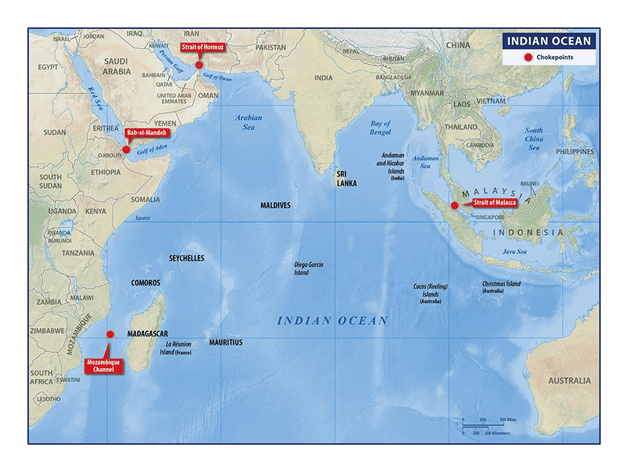The Indian Ocean, which spans across 3 continents covering 17.5% of global land area has an historic importance ever since the 19th century. It was a region of key strategic importance for trade,security and natural resources. The Indian Ocean Region (IOR) has three of the world’s 7 key choke points. Choke points are points of natural congestion along two wider and important navigable passages. The three choke points are Strait of Malacca, the Strait of Hormuz, and Bab-el-Mandeb.
Source – www.journalsofIndia.com
The IOR which consists of these choke points, connects the east to the west thereby providing a gateway for a huge quantum of global trade, mineral resources, enriched with energy resources such as uranium, gold, diamond, etc. The Indian peninsula surrounded by the Indian ocean has all the trades coming through these routes.
India imports 70% of its oil, supplies of rich sources of metals such as manganese, nickel, cobalt, uranium, copper, and energy sources are obtained from the IOR. Security concerns in the form of piracy, terrorism activities, and unscientific fishing have led the government to take measures to safeguard its interest in these regions and increasing security near the Indian ocean. With India marching towards the position of a superpower for almost a decade and becoming the 5th largest economy in the world has raised a serious concern to its immediate competitor China which is eyeing for an ambitious position in the world.
China is creating a ring around India called the “String of Pearls ” termed by the media. It refers to the network created by China consisting of the Chinese military and its commercial facilities extending from the Chinese mainland to Sudan port. China has made many unilateral actions in the South China Sea and its aggression against countries like Japan, the Philippines, Indonesia, South Korea, etc have proven to be hegemonic. This shows a deliberate attempt in surrounding India which will eventually affect their trade and cause irregularities.
China has a history of debt-trapping countries like Kenya, Ethiopia, Angola, Mongolia, Nigeria, Sudan, Pakistan, Maldives, etc. Debt trap is a process in which billions of loans are dispensed by one country to the other and when the latter is unable to pay, they are demanded of several advantages or concessions. The most recent example of a country which is a victim of debt-trap is Sri Lanka. Sri Lanka was forced to hand over its Hambantota port project to China for 99 years after it fell into massive debt, which is a $1.4 Billion project, popularly known as the Colombo Port city which is 290 Km from India.
Source – www.flickr.com
This has become a major environmental concern affecting marine life and has given China an added advantage in holding a key strategic position against India. This has led India to be critical regarding its security as 70% of India’s container traffic passes through this region. In 2014, Chinese submarines docked in Sri Lanka despite India’s concerns and have docked nuclear missiles with radioactive material at the Hambantota port. Most of India’ s neighbouring countries have fallen into this debt-trap by China which has led to ‘Strategic Encircling’ of India.
This has also forced India to augment its intelligence and ensure counterintelligence operations. India was one of the most cyber-targeted countries globally in 2019, with over 50000 cyber attacks from China alone. On holding key positions surrounding India, and building up patches of the base in the Indian ocean, cyber threat has become a recent trend in warfare and also interrupting Satellite signals that might have an adverse effect on missile launch, important signal receiving and transmission during serious circumstances for countering terrorism and militant activities.
There have been cases of eavesdrop on Indian intelligence and communication when there were activities of spy ships near Andaman and Nicobar in the Indian Ocean. These activities prove to challenge India’s domination in the Indian Ocean. This has benefited Pakistan in proceeding with its Anti-Indian spy navigation and has made Sri Lanka a hub for vital points from which India can be countered.
These factors and geopolitical agendas of the countries and China’s desperation in cornering India has alarmed the government in increasing the military strength in the Indian Ocean region and also sharpening the surveillance in that region. Recently, the intelligence and enforcement agencies had increased their surveillance in Lakshadweep after the reports of ISIS terrorists and reports of it being a new base of terror, there were also reports of illegal drug peddling and Maoist insurgency. The Indian Navy recently conducted a naval exercise with the navies of the UAE and Saudi Arabia to showcase its presence in the Persian Gulf region, serving as a reminder to China of the presence of the Indian Navy in the IOR.
Source – dailymirror
The UNSC debate presided by the Hon’ble Prime Minister Narendra Modi was about tackling and effectively countering maritime crime and strengthening the coordination. PM Modi said “We should remove barriers to maritime trade. Our prosperity depends on the active flow of maritime trade & barriers in this path can pose a challenge to the entire global economy. Free maritime trade is associated with the culture of India for time immemorial”.
India has also been actively vocal expansionism and hegemony signing various pacts like the SAGAR, Seychelles pact to build naval facilities and has ensured to keep an Iron Fist against the security issues of the country.
Written by- Venkatavardhan S
Edited by- Oishika Ghoshal
The post India’s Efforts to increase military presence in the Indian Ocean appeared first on The Economic Transcript.

